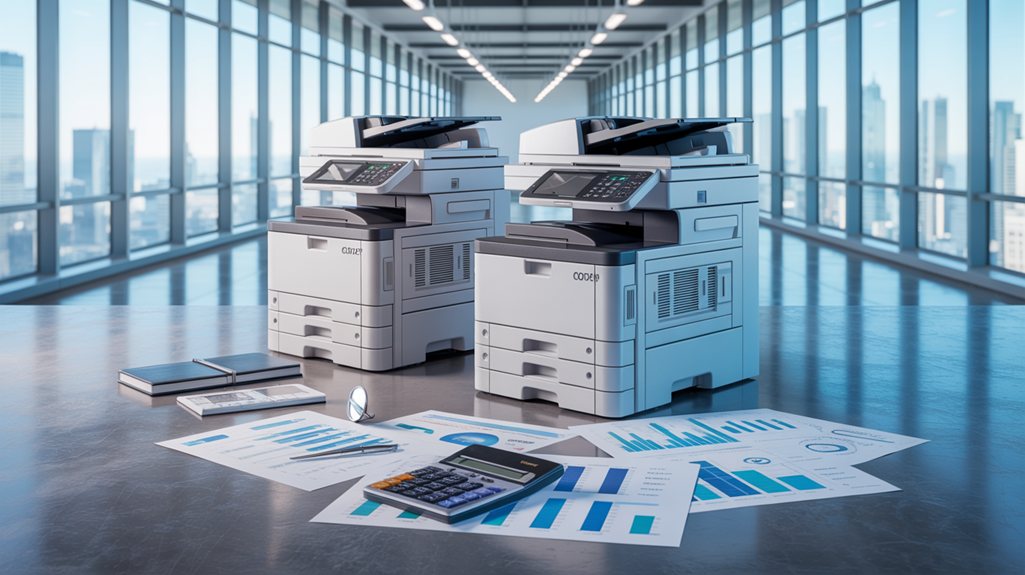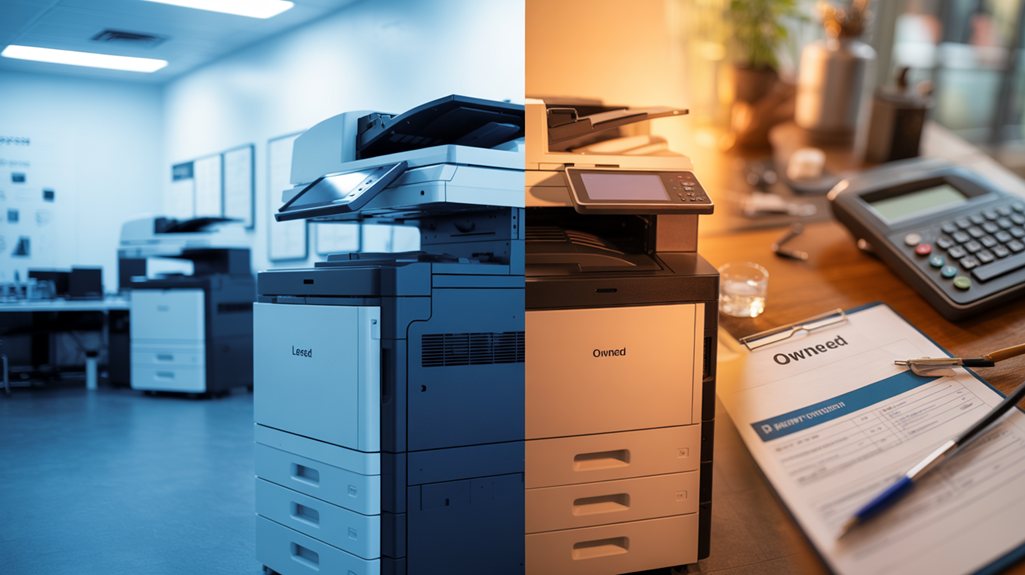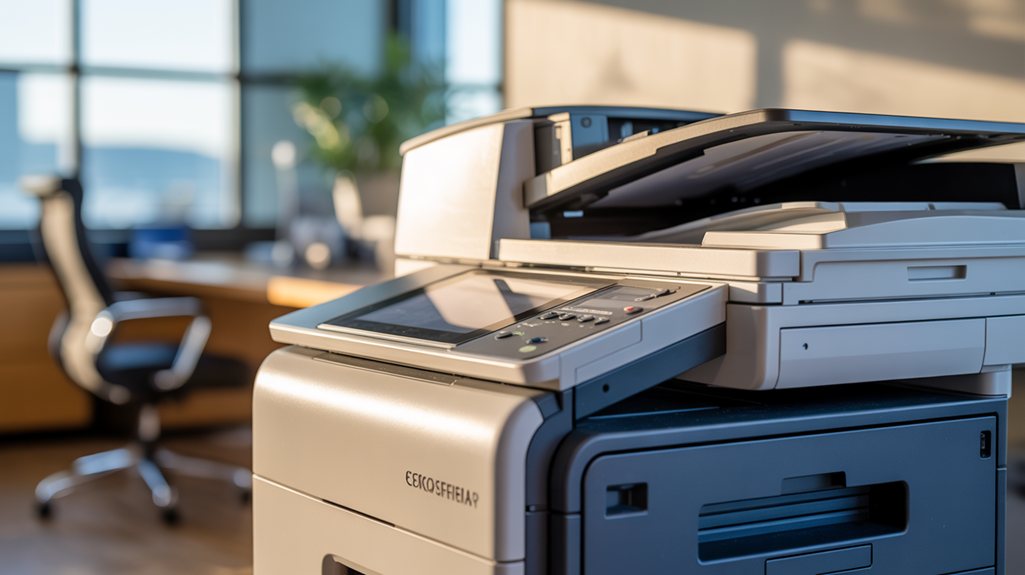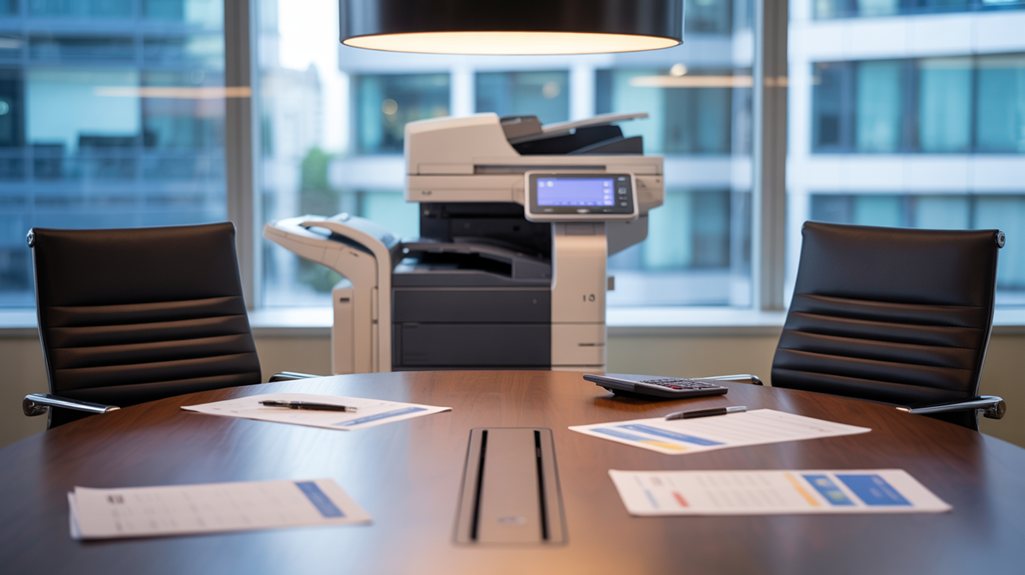
How to Upgrade Your Office Copier Without Exceeding Budget
Upgrading office copiers on a tight budget requires strategic choices beyond simple price comparisons. Leasing typically offers predictable monthly costs with maintenance included, while certified refurbished models deliver 30-50% savings compared to new equipment while maintaining performance standards. Negotiating competitive quotes, timing purchases around seasonal promotions and lease expirations, and evaluating total cost of ownership—including maintenance and energy consumption—reveal substantial savings opportunities. Understanding these interconnected factors opens the real path toward affordable modernization.
Expert Highlights
- Consider certified refurbished copiers to access modern features at 30-50% savings versus new equipment.
- Gather multiple vendor quotes with identical specifications to leverage competitive bids for better pricing.
- Time purchases with seasonal promotions and lease expirations to secure discounts and avoid penalty fees.
- Bundle services like equipment, maintenance, and supplies with vendors for substantial cost reductions.
- Calculate five-year total cost of ownership including maintenance, supplies, and energy to compare options fairly.
Leasing vs. Buying: Which Option Saves You More Money

Most businesses face a critical decision when their office copier needs upgrading: should they lease equipment or purchase it outright?
Leasing offers predictable monthly costs and includes maintenance, reducing unexpected expenses and operational headaches. Companies maintain budget control with fixed payments, making financial forecasting straightforward. Conversely, purchasing requires significant upfront capital investment but builds equity over time. Businesses that buy equipment own an asset depreciating gradually while potentially claiming tax deductions.
For organizations prioritizing flexibility and minimal capital expenditure, leasing provides superior control over cash flow. Companies needing advanced technology without long-term commitment benefit substantially from lease agreements. JR Copier of Minnesota offers subscription rental plans starting at $95/month with all-inclusive service that eliminates unexpected repair costs. However, businesses planning extended equipment use and possessing available capital often achieve greater long-term savings through purchase. The decision fundamentally depends on individual financial capacity, technology needs, and operational priorities.
The Benefits of Certified Refurbished Copiers

Businesses upgrading their office equipment often find themselves caught between two competing pressures: the need for reliable, modern technology and the constraint of limited budgets. Certified refurbished copiers offer a compelling solution to this dilemma. These machines undergo rigorous testing and restoration by manufacturers or authorized technicians, ensuring performance standards match new units at considerably lower costs—typically 30-50% savings. Unlike used equipment, refurbished models come with warranties and support guarantees, providing substantial protection for your investment. Organizations gain access to advanced features like faster printing speeds and enhanced security capabilities without premium pricing. This approach delivers measurable control over capital expenditures while maintaining operational reliability, making it an intelligent choice for budget-conscious businesses seeking modern functionality without financial overextension. Our factory-trained technicians can service refurbished copiers from all major brands, ensuring your upgraded equipment receives expert maintenance and support throughout its lifecycle.
Negotiating Better Rates With Equipment Vendors

When upgrading office copiers, organizations face significant costs that can strain budgets, making vendor negotiations essential to achieving financial goals. By gathering competitive quotes from multiple equipment providers, decision-makers gain leverage to request better pricing, lower maintenance fees, or extended service agreements that reduce long-term expenses. Additionally, bundling services—such as combining copier purchases with supplies, maintenance plans, and technical support into single contracts—often qualifies businesses for substantial discounts while streamlining vendor relationships and simplifying budget management. Understanding rental agreement terms before negotiating can help organizations identify which contract provisions offer the most flexibility and cost savings potential.
Leverage Competitive Quotes Effectively
Getting multiple quotes from different copier vendors is one of the most straightforward ways to reduce equipment costs, yet many office managers approach this process without a clear strategy, missing opportunities to negotiate better rates. The problem stems from accepting initial offers passively rather than leveraging competition strategically.
To gain control, managers should request detailed quotes specifying identical specifications from at least three vendors, ensuring fair comparison. When presenting competing bids to each vendor, many will lower prices to secure the contract. This competitive pressure creates leverage. Document all proposals carefully, noting not just price but maintenance terms, warranty coverage, and supply costs over the contract period. By systematically comparing total cost of ownership rather than purchase price alone, managers can identify genuine savings opportunities and negotiate confidently from a position of informed authority.
Bundle Services for Savings
Most office managers negotiate copier purchases as isolated transactions, treating the equipment, maintenance, and supply contracts as separate line items that vendors price independently, which leaves significant savings on the table.
Bundling services consolidates these separate agreements into one all-encompassing package, giving vendors incentive to lower overall pricing. When you propose combining equipment purchase, maintenance plans, and supply delivery, vendors compete harder because they secure long-term revenue streams.
Request tiered pricing structures where bundled services cost substantially less than individual components. For example, a vendor might reduce equipment costs by 15-20% when pairing it with a three-year maintenance agreement and toner supply contract. This approach strengthens your negotiating position while providing vendors predictable income, creating mutual financial benefit that translates directly into budget control and operational efficiency.
Timing Your Purchase for Maximum Savings
Strategic timing plays a pivotal role in reducing copier upgrade costs, yet many office managers overlook this opportunity by purchasing equipment whenever immediate needs arise. This reactive approach typically results in paying premium prices and missing seasonal discounts.
Smart purchasing requires monitoring vendor promotions and industry cycles. Equipment manufacturers typically offer substantial rebates during fiscal quarters when sales targets matter most—usually late summer and year-end periods. Waiting strategically can yield 15-25% savings compared to urgent purchases.
Additionally, planning upgrades before lease agreements expire prevents penalty fees and allows negotiating favorable trade-in terms. For businesses in the Minneapolis-St. Paul area, partnering with a local service provider who offers same-day service can streamline the upgrade process while maintaining operational continuity. Office managers who coordinate purchases with budget cycles maintain stronger financial control while securing better equipment specifications at reduced costs, ultimately protecting departmental resources for other priorities.
Evaluating Total Cost of Ownership
Beyond the initial purchase price lies a hidden financial landscape that often determines whether a copier upgrade truly delivers value or drains resources over time. Organizations frequently overlook maintenance costs, supply expenses, and energy consumption when budgeting for equipment.
The problem: A cheaper copier may require expensive repairs, demand premium toner cartridges, or consume excessive electricity, ultimately costing more annually than a higher-priced alternative. This reality leaves decision-makers vulnerable to unexpected budget overruns.
The solution involves calculating total cost of ownership by examining per-page printing costs, warranty coverage, average repair frequency, and energy ratings across competing models. Request detailed breakdowns from vendors; compare five-year projections rather than sticker prices. Consider whether all-inclusive service coverage that includes maintenance and repairs might provide greater financial predictability and eliminate surprise expenses.
This approach grants you complete financial transparency, preventing costly surprises while ensuring your upgrade investment truly aligns with operational budgets.
Optimizing Your Current Equipment Before Upgrading
Before investing in a new copier, organizations should maximize their current equipment’s lifespan and performance through consistent maintenance and strategic adjustments, since regular servicing prevents costly breakdowns while optimized settings—such as default print quality levels and toner-saving modes—can substantially reduce operational expenses. Proper maintenance routines, including cleaning feed rollers and replacing worn components, extend equipment life by years and maintain print quality, whereas configuring device settings to match actual workflow needs eliminates waste and improves efficiency without capital expenditure. JR Copier of Minnesota offers preventive maintenance plans that help organizations identify potential issues before they become expensive problems. These practical improvements often reveal whether an upgrade is truly necessary or whether existing equipment can continue serving the organization effectively, allowing budget allocation toward other priorities while maintaining productivity.
Maintenance Extends Equipment Life
When copiers accumulate dust, toner residue, and mechanical wear without regular attention, their performance deteriorates rapidly—causing paper jams, color inconsistencies, and reduced copy quality that frustrate users and lower productivity.
Strategic maintenance directly extends equipment lifespan and preserves your investment:
- Schedule monthly cleaning to remove toner buildup from internal components and mirrors
- Replace drums and fusers before they fail, preventing costly emergency repairs
- Calibrate color settings quarterly to maintain print quality and reduce waste
- Track service records to identify recurring issues before they escalate
Preventive maintenance costs considerably less than emergency repairs or premature replacement. Regular upkeep keeps machines operating at peak efficiency, reducing downtime and maintaining consistent output quality. Organizations that implement structured maintenance programs delay upgrades by 2-3 years, substantially stretching budget cycles and maximizing equipment value.
Settings Boost Performance Efficiency
Many office managers overlook a straightforward yet powerful opportunity to improve copier performance: adjusting the machine’s built-in settings to match actual workflow demands. Most copiers ship with default configurations that prioritize versatility over efficiency, leaving significant performance gains untapped. By strategically reconfiguring settings, managers can reduce processing times, lower energy consumption, and extend equipment lifespan—all without purchasing new hardware.
| Setting | Default | Optimized | Benefit |
|---|---|---|---|
| Resolution | 600 DPI | 300 DPI (standard docs) | 40% faster output |
| Warm-up Time | Always active | Scheduled intervals | 25% energy savings |
| Toner Darkness | Medium | Adjusted per job type | Consistent quality |
| Auto-off Timer | 30 minutes | 10 minutes | Reduced waste |
Managers retain complete control over these adjustments, enabling customization to specific operational needs and immediate measurable results.
Exploring Trade-In and Upgrade Programs
Most organizations face a critical challenge when their existing copiers become outdated or start requiring expensive repairs: deciding whether to continue pouring money into maintenance or invest in new equipment, which often seems financially impossible given tight budgetary constraints.
Trade-in and upgrade programs offer organizations meaningful control over equipment costs. Consider these strategic options:
- Manufacturer trade-in programs that credit old equipment toward new purchases
- Lease-to-own arrangements allowing gradual payment spreads
- Certified refurbished copiers offering significant savings with warranty protection
- Volume purchase discounts when upgrading multiple machines simultaneously
These programs directly reduce out-of-pocket expenses while eliminating aging equipment liability. Organizations gain access to advanced features, improved efficiency, and predictable maintenance costs, transforming what appears financially impossible into an achievable investment that strengthens operational control and reduces long-term expenditures substantially.
Frequently Asked Questions
What Environmental Certifications Should I Look for in Upgraded Copier Models?
Organizations should prioritize EPEAT Gold or Silver certification, Energy Star qualification, and ISO 14001 environmental management standards. These certifications guarantee reduced energy consumption, minimal waste generation, and responsible manufacturing practices that align with corporate sustainability objectives.
How Do I Train Staff to Use New Copier Features Efficiently?
Organizations should implement structured training sessions covering all new features, distribute detailed user manuals, designate power users as internal resources, schedule refresher courses quarterly, and monitor usage metrics to identify skill gaps requiring additional instruction.
What Warranty Coverage Is Typically Included With Refurbished Copiers?
Refurbished copiers typically include 12-month warranties covering parts and labor. Some vendors offer extended protection plans. Buyers should verify coverage specifics, including toner supplies, maintenance calls, and on-site service provisions before committing to purchase agreements.
How Often Should Copiers Be Serviced to Maintain Optimal Performance?
Copiers require servicing every 100,000 to 200,000 pages or quarterly, whichever occurs first. Regular maintenance prevents breakdowns, extends equipment lifespan, and guarantees consistent output quality. Organizations maintain operational control through predictable service schedules and preventive inspections.
Can Copier Upgrades Integrate With Existing Office Management Software Systems?
Modern copier upgrades typically integrate seamlessly with existing office management software through API connections and compatibility protocols. Organizations maintain full control over integration parameters, data flow, and system configurations during implementation procedures.
Expert Final Thoughts
Upgrading office copiers requires balancing immediate needs against long-term expenses. Organizations that thoroughly evaluate leasing versus purchasing, explore refurbished options, negotiate vendor rates, and consider trade-in programs typically reduce costs by 20-40%. Optimizing current equipment before upgrading and timing purchases strategically further stretches budgets. By implementing these approaches systematically, businesses achieve modern functionality without financial strain.